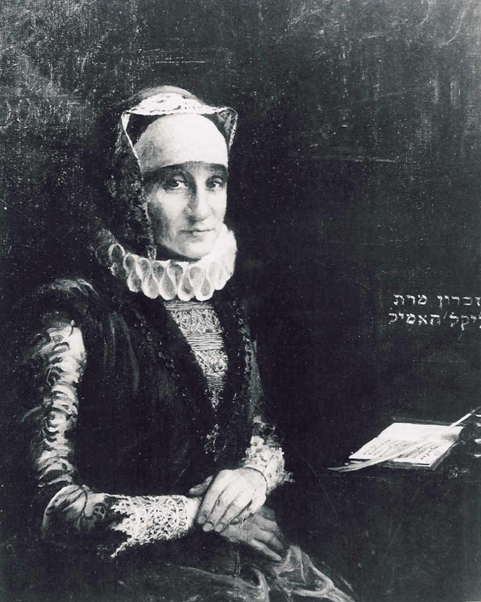
Glückl of Hameln (also spelled Gluckel, Glueckel, or Glikl of Hamelin; also known as Glikl bas Judah Leib) (1646 – September 19, 1724) was an extraordinary Jewish businesswoman and diarist, whose account of life provides scholars with an intimate picture of German Jewish communal life in the late-17th-early 18th century.
Glückl was born in Hamburg in 1645 into an affluent family of merchants as Glückl bas Juda Leib.
When she was 12 years old, her parents betrothed her to Chayim of Hameln, whom she married at age 14. She gave birth to 14 children, two of whom died in infancy. In addition to supervising a large household, raising and educating her children, and finding marriage matches for them, Glückl was an active partner in her husband’s business matters. The family business consisted mainly of trading in jewelry and precious stones and, to a lesser degree, money-lending and financial transactions. Not only was she frequently asked for her advice and opinion, but she herself interviewed agents, considered potential business partners, drew up partnership agreements, kept the accounting books.
Chayim died in 1689, with eight of her children still unmarried and living at home. When he was asked on his deathbed whether he wished to leave any final advice, he replied: “I have no instructions. My wife, she knows everything. Let her do as she has done until now.” Glückl continued single-handedly to manage the family’s business affairs in Hamburg (where she also opened a sock factory) and traveled to trade fairs she in other cities all across Europe as the head of the family business.
However, Chayim’s death depressed her and she tried to overcome her loss by writing a diary, a memoir of her life. She began it when she was forty six, in 1691, and completed the first five sections in 1699. The last two chapters are written 15 years later, after her remarriage and the death of her second husband. Copies of her manuscript were made by her descendants, and the Memoirs were published for the first time in Yiddish in 1896.
Although intended to be a personal memoir to acquaint her children and grandchildren with their family background, Glückl’s writings became incredibly important to historians because they are the only Jewish document about that period written by a woman. The memoir abounds in very detailed descriptions of day-to-day Jewish life in the German Jewish communities and other Jewish communities that Glückl visited in her extensive travels; it also tells of the impact of events in distant Jewish communities, such as the false messiah Shabetai Zvi.
Glückl had an excellent memory, a kind temperament, a poetic gift of expression, a good traditional education, and a pious disposition. She was well versed in the legendary lore of the Talmud and had read the popular Yiddish ethical books. She often made use in her memoirs of parables, fables, folk tales, and stories that illustrated a moral.
After eleven years of widowhood (during which she rejected many offers of marriage) and after marrying off all her children except for her youngest daughter, Glückl made the biggest mistake of her life; she married a wealthy banker, Hirsch Levy of Metz in 1700. The financial status of her second husband—to whom she had entrusted all her money and even her daughter’s dowry—gradually deteriorated to the point of bankruptcy, and when he died in 1711 Glückl was left penniless. She was forced to spend her final years dependent on her daughter and son-in-law in Metz and living under their roof—a situation that she had always feared and worked throughout her life to avoid. Glückl died in 1724, at the age of 78.
